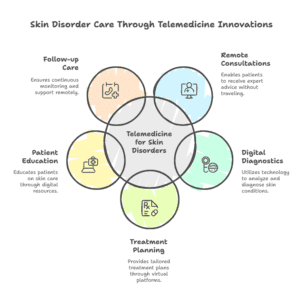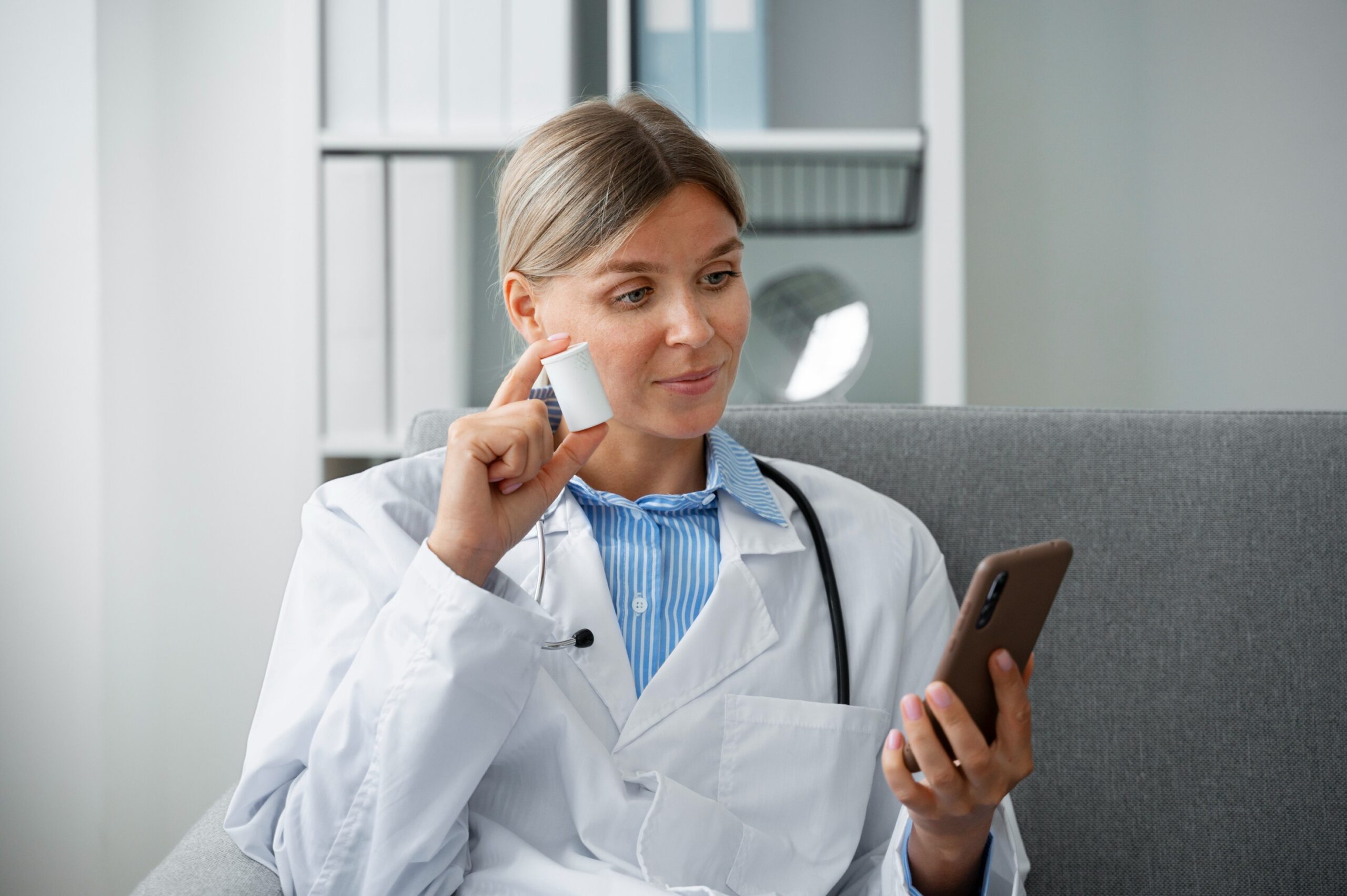Skin disorders, ranging from acne and eczema to more severe conditions like psoriasis or melanoma, can significantly impact a person’s health and quality of life. Traditionally, managing skin conditions involved in-person visits to dermatologists for diagnosis, treatment, and follow-up care. However, with the advancement of telemedicine, patients now have access to virtual dermatology consultations and care, making it easier to manage skin conditions remotely.
Telemedicine is revolutionizing how dermatological care is delivered by improving accessibility, enhancing the speedof diagnosis, and providing continuous monitoring for patients with chronic skin conditions. In this article, will explore how telemedicine is benefiting the management of skin disorders and improving patient outcomes.
Why Telemedicine is Important for Skin Disorders
Telemedicine for dermatology, also known as teledermatology, involves using video calls, images, and patient records to diagnose and treat skin conditions remotely. Why this is crucial for skin disorders:
- Increased access: Telemedicine makes dermatology consultations available to patients in rural or underserved areas where dermatologists may not be readily available.
- Convenience: Patients can consult with dermatologists from the comfort of their homes, saving time and reducing the need for in-person visits.
- Cost-effective: Telemedicine reduces travel costs and eliminates the need for patients to take time off from work for appointments.
- Faster treatment: Virtual consultations and remote monitoring allow for quicker diagnoses and early treatment, preventing conditions from worsening.
Telemedicine makes dermatological care more accessible, efficient, and effective for both patients and healthcare providers.
How Telemedicine Supports the Management of Skin Disorders

1. Remote Skin Condition Diagnosis
Telemedicine enables dermatologists to evaluate skin conditions through video consultations or by reviewing images uploaded by patients. Benefits include:
- Image sharing: Patients can upload high-quality images of their skin conditions, allowing dermatologists to make an informed diagnosis remotely.
- Efficient consultations: During a virtual visit, dermatologists can evaluate visible symptoms and discuss medical history to make accurate diagnoses quickly.
- Early intervention: Telemedicine helps identify conditions like skin cancer or infections early, improving the chances of successful treatment outcomes.
2. Virtual Follow-Up Appointments
Managing chronic skin conditions, such as acne, eczema, or psoriasis, requires ongoing care and monitoring. Telemedicine makes it easier for patients to maintain consistent follow-up care. Key benefits include:
- Convenient check-ups: Patients can schedule virtual follow-up appointments without the need to visit a clinic, making it easier to stay on track with their treatment plan.
- Monitoring treatment progress: Dermatologists can assess the effectiveness of treatments and adjust prescriptions or treatment plans based on feedback from virtual consultations.
- Continuous care: Virtual follow-ups allow dermatologists to monitor chronic conditions and intervene early if flare-ups or complications occur.
3. Access to Specialist Care
Not all regions have access to a specialist dermatologist, and patients in rural or remote areas may face long wait times for appointments. Telemedicine bridges this gap by:
- Accessing remote expertise: Patients can consult with top dermatologists regardless of location, increasing access to specialized care for skin disorders.
- Quick access to care: Telemedicine reduces wait times for appointments, allowing patients to receive timely care for acute or chronic conditions.
- Reducing geographic disparities: Patients in underserved areas no longer need to travel long distances to see a dermatologist, helping to reduce healthcare inequalities.
4. Managing Chronic Skin Conditions
Chronic skin conditions, such as eczema, psoriasis, and rosacea, require ongoing monitoring and management. Telemedicine makes it easier for patients to receive continuous care and improve the management of these conditions. Benefits include:
- Remote symptom tracking: Patients can track and report their symptoms from home, allowing dermatologists to assess flare-ups and adjust treatments accordingly.
- Customized treatment plans: Dermatologists can create personalized treatment plans based on regular remote assessments, improving long-term management of chronic conditions.
- Reduced need for in-office visits: Telemedicine reduces the number of in-person visits required, making it more convenient for patients while still providing effective treatment.
5. Monitoring Skin Cancer
Skin cancer, especially melanoma, is one of the most common types of cancer. Early detection is crucial for successful treatment. Telemedicine plays a significant role in improving early detection and monitoring of skin cancer. How telemedicine helps:
- Remote skin checks: Patients can share images of moles or suspicious growths, allowing dermatologists to assess whether further investigation is necessary.
- Reduced barriers to care: Telemedicine makes it easier for patients to consult dermatologists about new or changing moles, ensuring prompt action when needed.
- Efficient referrals: If a dermatologist identifies a potential skin cancer concern, they can quickly refer the patient to an in-person consultation or biopsy, ensuring timely treatment.
6. Teledermatology for Dermatological Emergencies
Telemedicine can also assist in urgent dermatological conditions, such as rashes, burns, or infections. How it helps:
- Immediate consultation: Patients can consult with a dermatologist virtually, receiving immediate advice on how to manage their condition or when to seek urgent care.
- Guidance for first aid: Dermatologists can provide instructions for treating minor skin conditions at home, reducing the need for emergency visits.
- Avoiding unnecessary ER visits: By offering virtual consultations for non-life-threatening conditions, telemedicine reduces the pressure on emergency rooms and helps manage healthcare resources efficiently.
7. Telemedicine for Pediatric Skin Conditions
Pediatric skin conditions, such as eczema, impetigo, or cradle cap, can be difficult for parents to manage. Telemedicine is particularly beneficial for families who need quick access to pediatric dermatology. Key advantages include:
- Parental convenience: Parents can consult with pediatric dermatologists from home, saving time and reducing the stress of taking young children to in-person appointments.
- Better communication: Dermatologists can guide parents on how to care for their children’s skin conditions, providing education and reassurance.
- Quick resolution of concerns: Telemedicine allows for quicker diagnosis and treatment, reducing the likelihood of skin conditions worsening in children.
Conclusion
Telemedicine is revolutionizing the way skin disorders are managed by improving access to care, enabling early diagnosis, and supporting ongoing treatment for chronic conditions. With its ability to deliver high-quality, convenient, and affordable care, telemedicine is enhancing the patient experience and making skin care more accessible to those who need it most. Whether for routine check-ups, emergency consultations, or managing chronic conditions, telemedicine is playing a key role in improving outcomes and empowering patients to take control of their skin health.
What People Are Asking
1. How does telemedicine benefit skin disorder management?
Telemedicine allows for remote consultations, early diagnosis, continuous monitoring, and follow-up care, improving access to dermatological care and outcomes for skin conditions.
2. Can telemedicine diagnose skin conditions?
Yes, telemedicine allows dermatologists to evaluate skin conditions through images or video consultations, making accurate diagnoses remotely.
3. How does telemedicine help with chronic skin conditions?
Telemedicine enables remote monitoring and virtual follow-up visits, ensuring ongoing management of chronic skin conditions like eczema, psoriasis, and acne.
4. Is telemedicine effective for skin cancer monitoring?
Telemedicine enables patients to share images of suspicious moles or growths with dermatologists, allowing for early detection and timely referrals for further evaluation.
5. How does telemedicine improve access to dermatological care?
Telemedicine increases access to dermatologists, especially in rural or underserved areas, by offering remote consultations and reducing the need for long-distance travel.
Disclaimer
For informational purposes only; not applicable to specific situations.
For tailored support and professional services,
please contact Staffingly, Inc. at (800) 489-5877
Email: support@staffingly.com.
About This Blog: This Blog is brought to you by Staffingly, Inc., a trusted name in healthcare outsourcing. The team of skilled healthcare specialists and content creators is dedicated to improving the quality and efficiency of healthcare services. The team passionate about sharing knowledge through insightful articles, blogs, and other educational resources.
 Book a Demo to Build Your Team Today!
Book a Demo to Build Your Team Today!

 Read Case Studies
Read Case Studies 


 Virtual Medical Assistants
Virtual Medical Assistants



